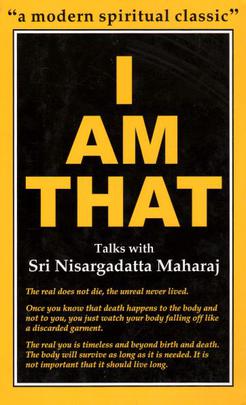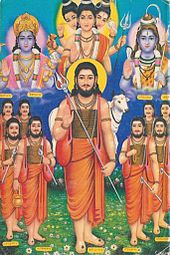
Sant Dnyaneshwar, also referred to as Dnyaneshwar, Dnyanadeva, Dnyandev or Mauli or Dnyaneshwar Vitthal Kulkarni (1275–1296), was a 13th-century Indian Marathi saint, poet, philosopher and yogi of the Nath and Varkari tradition. In his short life of 21 years, he authored Dnyaneshwari and Amrutanubhav. These are the oldest surviving literary works in the Marathi language, and considered to be milestones in Marathi literature. Sant Dnyaneshwar's ideas reflect the non-dualistic Advaita Vedanta philosophy and an emphasis on Yoga and bhakti towards Vithoba, an incarnation of Lord Vishnu. His legacy inspired saint-poets such as Eknath and Tukaram, and he is one of the founders of the Varkari (Vithoba-Krishna) Bhakti movement tradition of Hinduism in Maharashtra. Dnyaneshwar undertook samadhi at Alandi in 1296 by entombing himself in an underground chamber.

Nisargadatta Maharaj was an Indian guru of nondualism, belonging to the Inchagiri Sampradaya, a lineage of teachers from the Navnath Sampradaya.

Nath, also called Natha, are a Shaiva sub-tradition within Hinduism in India and Nepal. A medieval movement, it combined ideas from Buddhism, Shaivism and Yoga traditions of the Indian subcontinent. The Naths have been a confederation of devotees who consider Shiva as their first lord or guru, with varying lists of additional gurus. Of these, the 9th or 10th century Matsyendranatha and the ideas and organization mainly developed by Gorakhnath are particularly important. Gorakhnath is considered the originator of the Nath Panth.

Sant Sopandeo was a sant of the Varkari and also the younger brother of Dnyaneshwar.

Dāsbodh, loosely meaning "advice to the disciple" in Marathi, is a 17th-century bhakti (devotion) and jnana (insight) spiritual text. It was orally narrated by the saint Samarth Ramdas to his disciple, Kalyan Swami. The Dāsbodh provides readers with spiritual guidance on matters such as devotion and acquiring knowledge. Besides this, it also helps in answering queries related to day-to-day life and how to find solutions to it.

Narayan Maharaj was a Hindu Indian spiritual master considered by his followers to be a sadguru. He lived in the village of Kedgaon, east of the Indian city of Pune.

Sri Siddharameshwar Maharaj (1888–1936) was a guru in the Inchagiri Sampradaya founded by his guru Bhausaheb Maharaj, a branch of the Navnath Sampradaya, the 'Nine Masters' tradition in India. His disciples included Nath teachers Nisargadatta Maharaj, Ranjit Maharaj, Kaadsiddheshwar, and Ganapatrao Maharaj Kannur.

The Navnath, also spelt as Navnatha in vernacular languages, are the nine saints, Masters or Naths on whom the Navnath Sampradaya, the lineage of the nine gurus, is based. They are worshipped collectively as well as individually.

Siddhagiri Gramjivan Museum (Kaneri Math) at Kaneri, Kolhapur district, Maharashtra, is a sculpture museum. The full name is Siddhagiri Gramjivan (Village life) Museum. It is situated at Shri Kshetra Siddhagiri Math, a campus built around the Moola-Kaadsiddheswar Shiva temple.

Shri Samartha Sadaguru Ganapatrao Maharaj Kannur (1909–2004) was an Indian guru in the Inchegeri Sampradaya.

Shri Samarth Muppin Kaadsiddheswar Maharaj was a guru in the Navnath tradition of Hindu philosophy. He was a disciple of Shri Samarth Siddharameshwar Maharaj, disciple of Shri Samarth Bhausaheb Maharaj, disciple of Shri Gurulingajangam Maharaj, disciple of the 22nd Shri Samarth Muppin Kaadsiddheswar Maharaj.
Nivruttinath was a 13th-century Marathi Bhakti saint, poet, philosopher and yogi of the Vaishnava Nath tradition. He was the elder brother and the mentor (guru) of Dnyaneshwar, the first Varkari saint.

Swami Nigamananda Paramahansa was an Indian yogi, guru and mystic well known in Eastern India. He is associated with the Shakta tradition and viewed as a perfect spiritual master of vedanta, tantra, yoga and prema or bhakti. His followers idealized him as their worshipped and beloved thakura.

The Advaita Guru-Paramparā is the traditional lineage (parampara) of divine, Vedic and historical teachers of Advaita Vedanta. It begins with the Daiva-paramparā, the gods; followed by the Ṛṣi-paramparā, the Vedic seers; and then the Mānava-paramparā, with the historical teachers Gaudapada and Adi Shankara, and four of Shankara's pupils. Of the five contemporary acharyas, the heads of the five Advaita mathas, four acharyas trace their lineage to those four pupils and one to Adi Shankara himself.

Ramchandra Dattatrey Ranade (1886–1957) was an Indian scholar-philosopher-saint of Karnataka and Maharashtra.

I Am That is a compilation of talks on Shiva Advaita (Nondualism) philosophy by Sri Nisargadatta Maharaj, a Hindu spiritual teacher who lived in Mumbai. The English translation of the book from the original Marathi recordings was done by Maurice Frydman, edited by Sudhakar S. Dixit and first published in 1973 by Chetana Publications. The book was revised and reedited in July 1981. These publications led to the spread of Nisargadatta's teachings to the West, especially North America and Europe. Excerpts of the book were published in Yoga Journal in September 1981, the month Nisargadatta died at age 84.
According to Sarira Traya, the Doctrine of the Three bodies in Hinduism, the human being is composed of three shariras or "bodies" emanating from Brahman by avidya, "ignorance" or "nescience". They are often equated with the five koshas (sheaths), which cover the atman. The Three Bodies Doctrine is an essential doctrine in Indian philosophy and religion, especially Yoga, Advaita Vedanta, Tantra and Shaivism.
Shri Revan Natha, also known as Revan Siddh, Kada Siddha, and, Kaadhsiddheshwar Siddharaj was the 7th or 8th Navnath. He is especially worshipped in western India, where several temples are dedicated to him, and several sampradayas trace their origin to him, the best-known being the Inchegeri Sampradaya.
Sri Ranjit Maharaj was an Indian spiritual teacher in the Navnath Inchegeri Sampradaya tradition, and disciple of Siddharameshwar Maharaj.

Bhausaheb Maharaj was the founder of the Inchegeri Sampradaya, to which the well-known Indian guru Nisargadatta Maharaj belonged.























